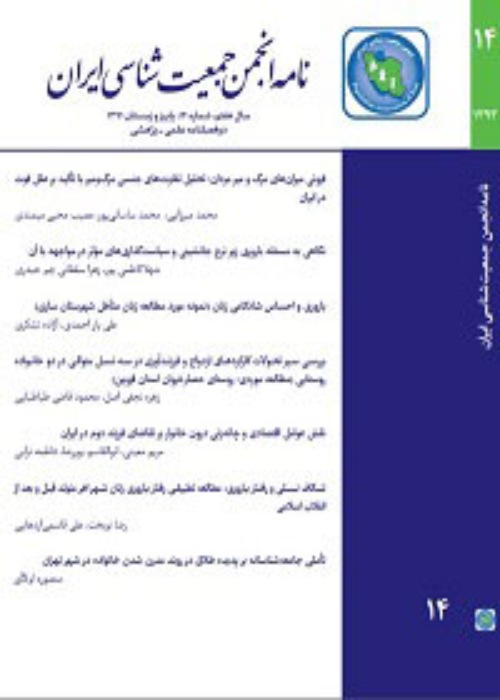Exploring the Semantic Underpinnings of Marriage among Iranian Women and Afghan Men
This study explores the semantic interpretation of marriage between Iranian women and Afghan men. With Iran becoming a significant hub for Afghan migrants in recent decades, driven by geographical proximity and intensified by political unrest, economic strife, and socio-political factors in Afghanistan, this research adopts a qualitative research methodology and grounded theory approach. Targeted sampling was utilized to enlist Iranian women married to Afghan men, with data gathered through semi-structured interviews. The sample included 12 women, determined by theoretical saturation. Data analysis involved a three-step coding process, identifying 106 concepts, 35 subcategories, 10 main categories, and one core category. The main categories covered causal conditions such as patriarchy and forced marriage, contextual factors like family difficulties and poverty, and interventional aspects such as diverse response perceptions and legal barriers. The core category highlighted the theme of "unwanted selection and life." The findings reveal significant challenges in the marriages of Iranian women to Afghan men, shaped by social conditions, leading to an undesirable trajectory for these women and their families.
Migration, a significant driver of demographic change, induces deep and multifaceted transformations within population, both in the long and short term. Afghanistan, due to historical and cultural ties with its neighbors and marked by political and economic turmoil, has become a prominent source of migrants to Iran.
In host countries, intermarriage between migrants and native populations is commonplace, signifying cultural assimilation and social integration. In Iran, the influx of Afghan migrants has increased the incidence of mixed marriages, bringing challenges for Iranian women stemming from cultural differences, societal stigma, and legal intricacies. With the growing number of such unions, issues like poverty, children's educational access, and lack of support services have emerged, highlighting the complex interplay between migration, cultural adaptation, and family dynamics in Iranian society. This study aims to explore the semantic underpinnings of mixed marriages and shed light on Iranian women's perceptions of these unions within the Iranian socio-cultural milieu.
Methods and Data:
This study adopts a qualitative research methodology and grounded theory framework, following Strauss and Corbin's systematic approach. The research focuses on Iranian women married to Afghan spouses, selecting Shiraz as the study's research field due to its long-standing acceptance of Afghan migrants, offering a suitable context for this inquiry. Participants were selected through purposive sampling and were chosen based on their readiness and willingness to participate in interviews. In-depth, semi-structured interviews were conducted with 12 participants, lasting between 40 to 90 minutes on average, recorded with participants' consent, transcribed word-for-word, and coded to identify both main and sub-themes.
Ensuring the credibility and trustworthiness of qualitative research is crucial. Guba and Lincoln (1994) criterion of "trustworthiness" was employed to evaluate the research's quality. The researchers avoided personal bias, precluding preconceived notions during data collection and analysis phases, thus reinforcing the credibility of the findings. Moreover, expert oversight and guidance were incorporated throughout the interviewing, data analysis, and coding stages to enhance the reliability of the data and the conclusions drawn. The participants were 12 Iranian women who were married to Afghan men, living in Shiraz. They mostly had education up to pre-secondary school and were aged between 30 to 48 years. These participants provided insights into their marital lives with Afghan spouses.
Through data coding and analysis, 106 concepts, 35 subcategories, 10 main categories, and one core category were identified. The study's main categories fell into primary conditions ("paternalistic attitudes and forced marriage," "cohesion and pressure from foreign nationals"), contextual conditions ("hardships within the paternal household," "lack and scarcity of awareness," "poverty and feelings of deprivation," and "fatalism"), and interventional conditions ("perceptions of diverse responses," "administrative and legal obstacles," "lack of foresight," "financial and occupational instability for foreign nationals").
The analysis of concepts and categories in the study reveals various factors influencing the marriages and lives of Iranian women with Afghan spouses. The challenges faced by some of these women range from
oscillating between coercion and a kind of enforced choice, includes hardships within the paternal household, lack of awareness, poverty, fatalism, paternalistic attitudes leading to forced marriage, cohesion and pressure from foreign nationals, and lack of foresight. The core category emerged is "unwanted selection and life," representing a coerced choice.
While exploring the semantic essence of these concepts, one theme stands out prominently: coerced choice. This theme underscores the lack of agency Iranian women face amidst numerous adversities, pushing them to endure a life they would not ordinarily choose, under normal circumstances. Their decisions are not choosing between good and excellent, or even good and bad options; but rather are between existence and non-existence. Therefore, what seems like a choice, it is actually a quest for survival rather than a true preference.
In conclusion, the extensive migration of Afghans to Iran and the resulting marriages between some of Iranian women and Afghan men have reshaped family dynamics and introduced challenges for some Iranian families. For these women, the usual and voluntary choice in marriage has been replaced by the acceptance of undesirable conditions that it seems to be their preferred choices. This family lifestyle bears psychological, identity, and social implications for the women, their families, and children resulting from these marriages. In this regard, further research on the multiple consequences of such marriages is recommended. From both an operational and legal standpoint, it is recommended to implement effective oversight of foreign nationals' presence and their marriages, coupled with a comprehensive reform of migration regulations.
This article is extracted from the master thesis of the first author in the field of demography, completed at the Faculty of Economics, Management and Social Sciences of Shiraz University. The authors appreciate the participants in the interviews of the research and the anonymous reviewers of the present paper for their constructive feedbacks.
- حق عضویت دریافتی صرف حمایت از نشریات عضو و نگهداری، تکمیل و توسعه مگیران میشود.
- پرداخت حق اشتراک و دانلود مقالات اجازه بازنشر آن در سایر رسانههای چاپی و دیجیتال را به کاربر نمیدهد.



